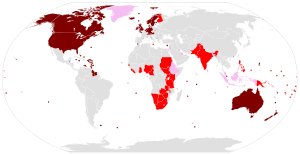Germanic languages
branch of the Indo-European language family
(Redirected from North Germanic languages)
The Germanic languages are a group of Indo-European languages. They came from one language, Proto-Germanic, which was first spoken in Scandinavia in the Iron Age. Today, the Germanic languages are spoken by around 515 million people as a first language.[1] English is the most spoken Germanic language, with 360-400 million native speakers.[2]
| Germanic | |
|---|---|
| Teutonic | |
| Geographic distribution: | Principally northern, western and central Europe, the Americas (Anglo-America, Caribbean Netherlands and Suriname), Southern Africa and Oceania |
| Linguistic classification: | Indo-European
|
| Proto-language: | Proto-Germanic |
| Subdivisions: |
East Germanic (extinct)
|
| ISO 639-2 and 639-5: | gem |
 World map showing countries where a Germanic language is the primary or official language Countries where (a) Germanic language(s) is/are the first language(s) of the majority of the population
Countries or regions where (a) Germanic language(s) is/are (an) official but not primary language(s)
Countries or regions where (a) Germanic language(s) is/are (an) unofficial but recognised/used in some areas of life/spoken among a local minority | |
The Germanic languages are the East Germanic languages (all extinct), the North Germanic languages, and the West Germanic languages.
When Proto-Germanic split from Proto-Indo-European, one of the main changes in the sounds in the language was Grimm’s law.
References
change- ↑ König & van der Auwera (1994).
- ↑ Crystal 2006, pp. 424–426.
Sources
change- König, Ekkehard; van der Auwera, Johan (1994). The Germanic languages. London: Routledge.
- Crystal, David (2006). "Chapter 9: English worldwide". In Denison, David; Hogg, Richard M. (eds.). A History of the English Language. Cambridge University Press. pp. 420–439. ISBN 978-0-511-16893-2.